ACCT19083 Final Assignment Term 3, 2017: CSR and Ethical Dilemmas
VerifiedAdded on 2020/05/16
|15
|6172
|208
Homework Assignment
AI Summary
This assignment addresses key concepts in business ethics and corporate social responsibility (CSR). It begins by defining a socially responsible business and providing examples like Google and Xerox, highlighting how CSR enhances brand value and benefits society. The assignment then examines Grameen Bank as a socially responsible enterprise, detailing its microcredit initiatives in Bangladesh and their impact on poverty alleviation. It emphasizes the bank's role in empowering rural communities and its financial success. Finally, the assignment explores ethical dilemmas, explaining the conditions that define them and differentiating between ethics, morals, values, laws, and policies. It provides examples of ethical dilemmas and discusses conflicting ethical standards within specific situations, such as those faced by social workers. The assignment utilizes several academic references to support its arguments and analysis.
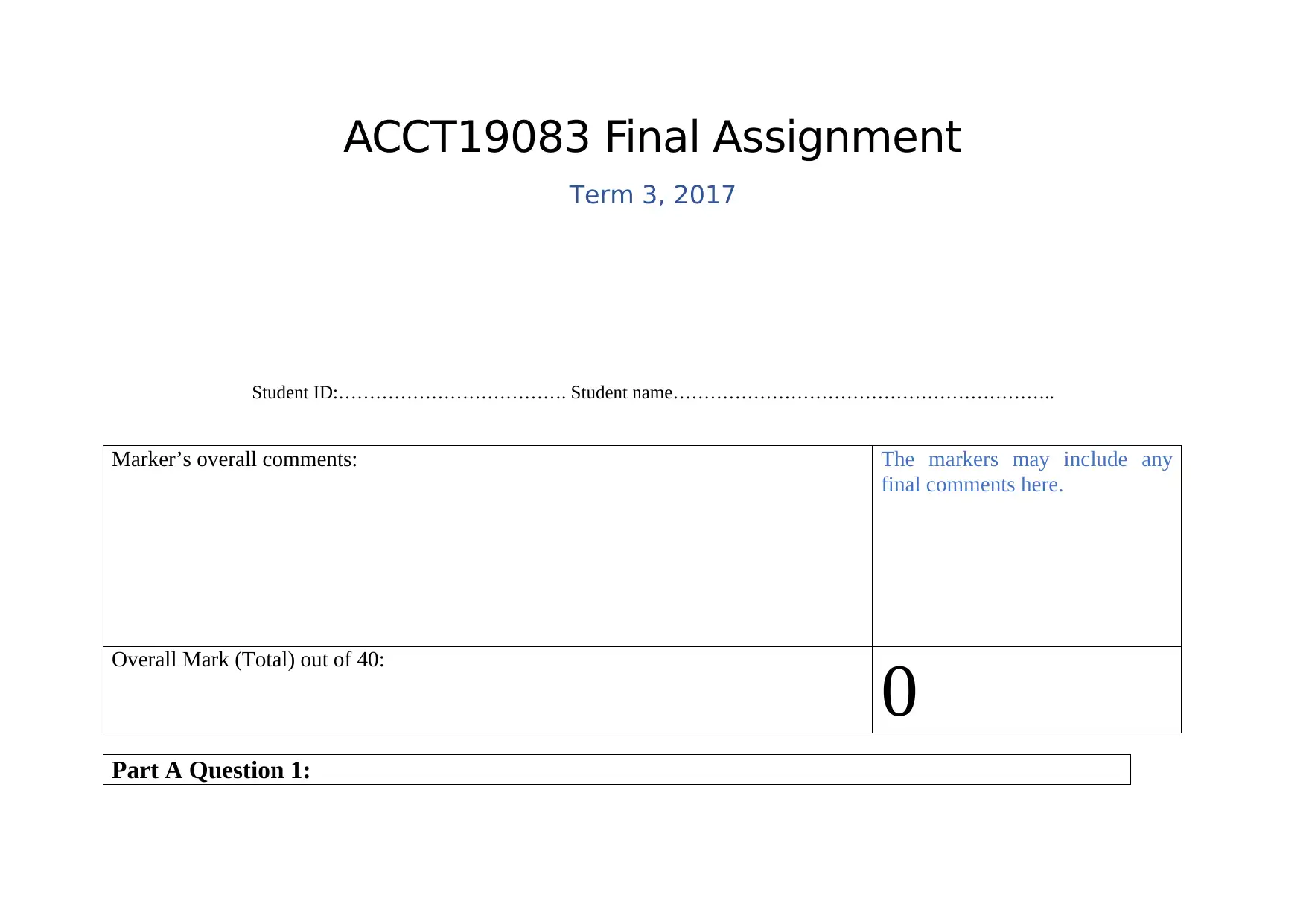
ACCT19083 Final Assignment
Term 3, 2017
Student ID:………………………………. Student name……………………………………………………..
Marker’s overall comments: The markers may include any
final comments here.
Overall Mark (Total) out of 40:
0
Part A Question 1:
Term 3, 2017
Student ID:………………………………. Student name……………………………………………………..
Marker’s overall comments: The markers may include any
final comments here.
Overall Mark (Total) out of 40:
0
Part A Question 1:
Paraphrase This Document
Need a fresh take? Get an instant paraphrase of this document with our AI Paraphraser
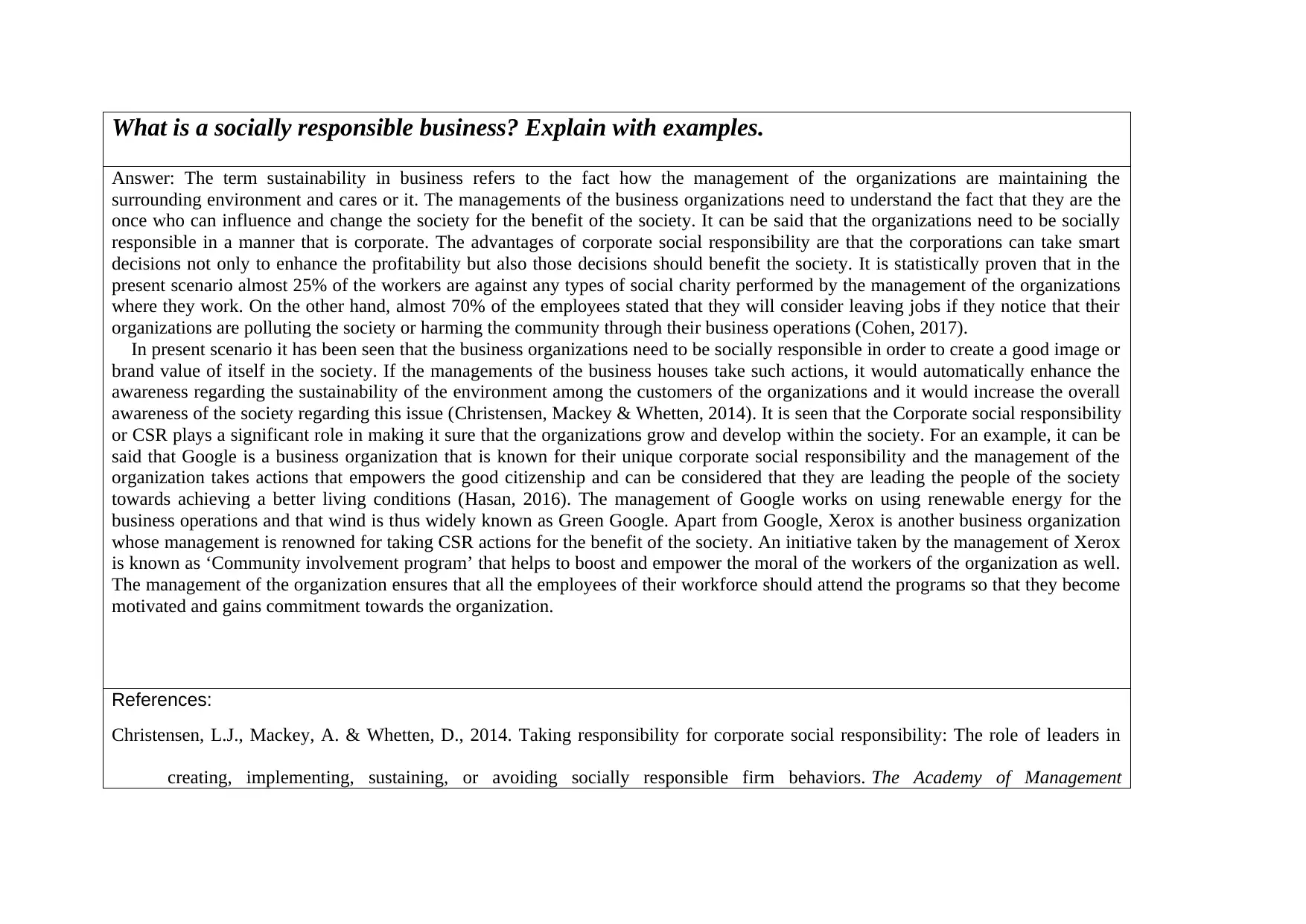
What is a socially responsible business? Explain with examples.
Answer: The term sustainability in business refers to the fact how the management of the organizations are maintaining the
surrounding environment and cares or it. The managements of the business organizations need to understand the fact that they are the
once who can influence and change the society for the benefit of the society. It can be said that the organizations need to be socially
responsible in a manner that is corporate. The advantages of corporate social responsibility are that the corporations can take smart
decisions not only to enhance the profitability but also those decisions should benefit the society. It is statistically proven that in the
present scenario almost 25% of the workers are against any types of social charity performed by the management of the organizations
where they work. On the other hand, almost 70% of the employees stated that they will consider leaving jobs if they notice that their
organizations are polluting the society or harming the community through their business operations (Cohen, 2017).
In present scenario it has been seen that the business organizations need to be socially responsible in order to create a good image or
brand value of itself in the society. If the managements of the business houses take such actions, it would automatically enhance the
awareness regarding the sustainability of the environment among the customers of the organizations and it would increase the overall
awareness of the society regarding this issue (Christensen, Mackey & Whetten, 2014). It is seen that the Corporate social responsibility
or CSR plays a significant role in making it sure that the organizations grow and develop within the society. For an example, it can be
said that Google is a business organization that is known for their unique corporate social responsibility and the management of the
organization takes actions that empowers the good citizenship and can be considered that they are leading the people of the society
towards achieving a better living conditions (Hasan, 2016). The management of Google works on using renewable energy for the
business operations and that wind is thus widely known as Green Google. Apart from Google, Xerox is another business organization
whose management is renowned for taking CSR actions for the benefit of the society. An initiative taken by the management of Xerox
is known as ‘Community involvement program’ that helps to boost and empower the moral of the workers of the organization as well.
The management of the organization ensures that all the employees of their workforce should attend the programs so that they become
motivated and gains commitment towards the organization.
References:
Christensen, L.J., Mackey, A. & Whetten, D., 2014. Taking responsibility for corporate social responsibility: The role of leaders in
creating, implementing, sustaining, or avoiding socially responsible firm behaviors. The Academy of Management
Answer: The term sustainability in business refers to the fact how the management of the organizations are maintaining the
surrounding environment and cares or it. The managements of the business organizations need to understand the fact that they are the
once who can influence and change the society for the benefit of the society. It can be said that the organizations need to be socially
responsible in a manner that is corporate. The advantages of corporate social responsibility are that the corporations can take smart
decisions not only to enhance the profitability but also those decisions should benefit the society. It is statistically proven that in the
present scenario almost 25% of the workers are against any types of social charity performed by the management of the organizations
where they work. On the other hand, almost 70% of the employees stated that they will consider leaving jobs if they notice that their
organizations are polluting the society or harming the community through their business operations (Cohen, 2017).
In present scenario it has been seen that the business organizations need to be socially responsible in order to create a good image or
brand value of itself in the society. If the managements of the business houses take such actions, it would automatically enhance the
awareness regarding the sustainability of the environment among the customers of the organizations and it would increase the overall
awareness of the society regarding this issue (Christensen, Mackey & Whetten, 2014). It is seen that the Corporate social responsibility
or CSR plays a significant role in making it sure that the organizations grow and develop within the society. For an example, it can be
said that Google is a business organization that is known for their unique corporate social responsibility and the management of the
organization takes actions that empowers the good citizenship and can be considered that they are leading the people of the society
towards achieving a better living conditions (Hasan, 2016). The management of Google works on using renewable energy for the
business operations and that wind is thus widely known as Green Google. Apart from Google, Xerox is another business organization
whose management is renowned for taking CSR actions for the benefit of the society. An initiative taken by the management of Xerox
is known as ‘Community involvement program’ that helps to boost and empower the moral of the workers of the organization as well.
The management of the organization ensures that all the employees of their workforce should attend the programs so that they become
motivated and gains commitment towards the organization.
References:
Christensen, L.J., Mackey, A. & Whetten, D., 2014. Taking responsibility for corporate social responsibility: The role of leaders in
creating, implementing, sustaining, or avoiding socially responsible firm behaviors. The Academy of Management
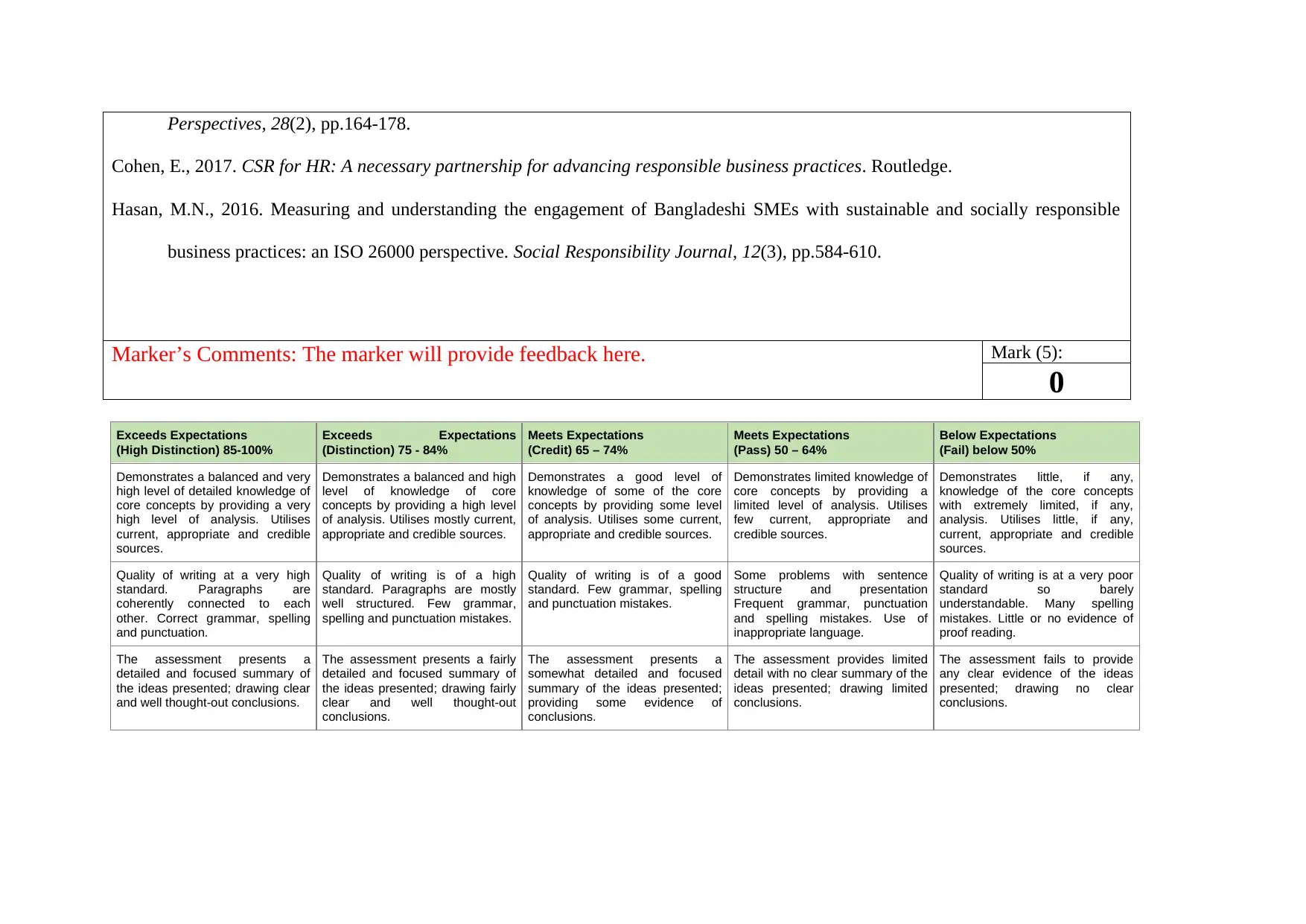
Perspectives, 28(2), pp.164-178.
Cohen, E., 2017. CSR for HR: A necessary partnership for advancing responsible business practices. Routledge.
Hasan, M.N., 2016. Measuring and understanding the engagement of Bangladeshi SMEs with sustainable and socially responsible
business practices: an ISO 26000 perspective. Social Responsibility Journal, 12(3), pp.584-610.
Marker’s Comments: The marker will provide feedback here. Mark (5):
0
Exceeds Expectations
(High Distinction) 85-100%
Exceeds Expectations
(Distinction) 75 - 84%
Meets Expectations
(Credit) 65 – 74%
Meets Expectations
(Pass) 50 – 64%
Below Expectations
(Fail) below 50%
Demonstrates a balanced and very
high level of detailed knowledge of
core concepts by providing a very
high level of analysis. Utilises
current, appropriate and credible
sources.
Demonstrates a balanced and high
level of knowledge of core
concepts by providing a high level
of analysis. Utilises mostly current,
appropriate and credible sources.
Demonstrates a good level of
knowledge of some of the core
concepts by providing some level
of analysis. Utilises some current,
appropriate and credible sources.
Demonstrates limited knowledge of
core concepts by providing a
limited level of analysis. Utilises
few current, appropriate and
credible sources.
Demonstrates little, if any,
knowledge of the core concepts
with extremely limited, if any,
analysis. Utilises little, if any,
current, appropriate and credible
sources.
Quality of writing at a very high
standard. Paragraphs are
coherently connected to each
other. Correct grammar, spelling
and punctuation.
Quality of writing is of a high
standard. Paragraphs are mostly
well structured. Few grammar,
spelling and punctuation mistakes.
Quality of writing is of a good
standard. Few grammar, spelling
and punctuation mistakes.
Some problems with sentence
structure and presentation
Frequent grammar, punctuation
and spelling mistakes. Use of
inappropriate language.
Quality of writing is at a very poor
standard so barely
understandable. Many spelling
mistakes. Little or no evidence of
proof reading.
The assessment presents a
detailed and focused summary of
the ideas presented; drawing clear
and well thought-out conclusions.
The assessment presents a fairly
detailed and focused summary of
the ideas presented; drawing fairly
clear and well thought-out
conclusions.
The assessment presents a
somewhat detailed and focused
summary of the ideas presented;
providing some evidence of
conclusions.
The assessment provides limited
detail with no clear summary of the
ideas presented; drawing limited
conclusions.
The assessment fails to provide
any clear evidence of the ideas
presented; drawing no clear
conclusions.
Cohen, E., 2017. CSR for HR: A necessary partnership for advancing responsible business practices. Routledge.
Hasan, M.N., 2016. Measuring and understanding the engagement of Bangladeshi SMEs with sustainable and socially responsible
business practices: an ISO 26000 perspective. Social Responsibility Journal, 12(3), pp.584-610.
Marker’s Comments: The marker will provide feedback here. Mark (5):
0
Exceeds Expectations
(High Distinction) 85-100%
Exceeds Expectations
(Distinction) 75 - 84%
Meets Expectations
(Credit) 65 – 74%
Meets Expectations
(Pass) 50 – 64%
Below Expectations
(Fail) below 50%
Demonstrates a balanced and very
high level of detailed knowledge of
core concepts by providing a very
high level of analysis. Utilises
current, appropriate and credible
sources.
Demonstrates a balanced and high
level of knowledge of core
concepts by providing a high level
of analysis. Utilises mostly current,
appropriate and credible sources.
Demonstrates a good level of
knowledge of some of the core
concepts by providing some level
of analysis. Utilises some current,
appropriate and credible sources.
Demonstrates limited knowledge of
core concepts by providing a
limited level of analysis. Utilises
few current, appropriate and
credible sources.
Demonstrates little, if any,
knowledge of the core concepts
with extremely limited, if any,
analysis. Utilises little, if any,
current, appropriate and credible
sources.
Quality of writing at a very high
standard. Paragraphs are
coherently connected to each
other. Correct grammar, spelling
and punctuation.
Quality of writing is of a high
standard. Paragraphs are mostly
well structured. Few grammar,
spelling and punctuation mistakes.
Quality of writing is of a good
standard. Few grammar, spelling
and punctuation mistakes.
Some problems with sentence
structure and presentation
Frequent grammar, punctuation
and spelling mistakes. Use of
inappropriate language.
Quality of writing is at a very poor
standard so barely
understandable. Many spelling
mistakes. Little or no evidence of
proof reading.
The assessment presents a
detailed and focused summary of
the ideas presented; drawing clear
and well thought-out conclusions.
The assessment presents a fairly
detailed and focused summary of
the ideas presented; drawing fairly
clear and well thought-out
conclusions.
The assessment presents a
somewhat detailed and focused
summary of the ideas presented;
providing some evidence of
conclusions.
The assessment provides limited
detail with no clear summary of the
ideas presented; drawing limited
conclusions.
The assessment fails to provide
any clear evidence of the ideas
presented; drawing no clear
conclusions.
⊘ This is a preview!⊘
Do you want full access?
Subscribe today to unlock all pages.

Trusted by 1+ million students worldwide
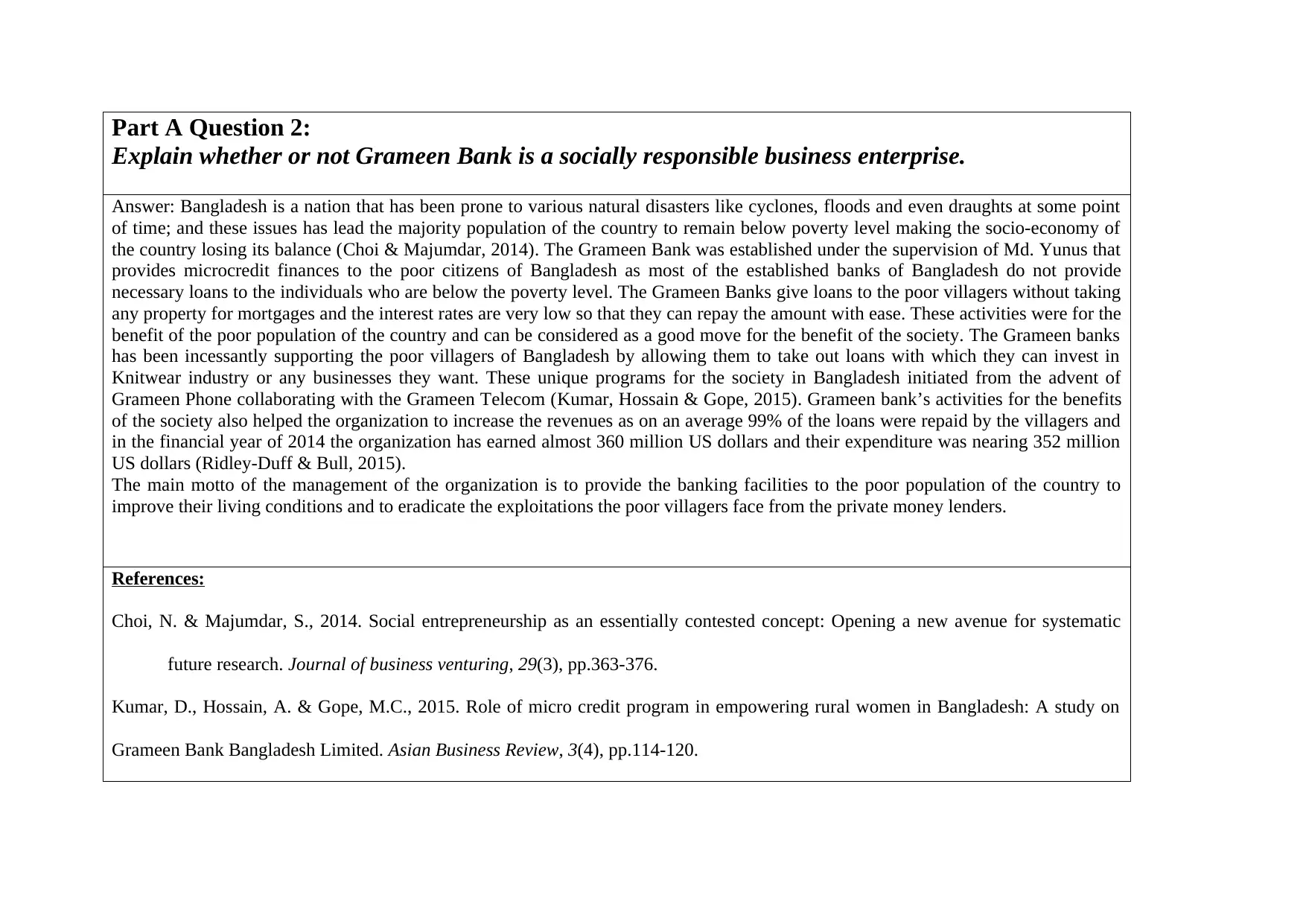
Part A Question 2:
Explain whether or not Grameen Bank is a socially responsible business enterprise.
Answer: Bangladesh is a nation that has been prone to various natural disasters like cyclones, floods and even draughts at some point
of time; and these issues has lead the majority population of the country to remain below poverty level making the socio-economy of
the country losing its balance (Choi & Majumdar, 2014). The Grameen Bank was established under the supervision of Md. Yunus that
provides microcredit finances to the poor citizens of Bangladesh as most of the established banks of Bangladesh do not provide
necessary loans to the individuals who are below the poverty level. The Grameen Banks give loans to the poor villagers without taking
any property for mortgages and the interest rates are very low so that they can repay the amount with ease. These activities were for the
benefit of the poor population of the country and can be considered as a good move for the benefit of the society. The Grameen banks
has been incessantly supporting the poor villagers of Bangladesh by allowing them to take out loans with which they can invest in
Knitwear industry or any businesses they want. These unique programs for the society in Bangladesh initiated from the advent of
Grameen Phone collaborating with the Grameen Telecom (Kumar, Hossain & Gope, 2015). Grameen bank’s activities for the benefits
of the society also helped the organization to increase the revenues as on an average 99% of the loans were repaid by the villagers and
in the financial year of 2014 the organization has earned almost 360 million US dollars and their expenditure was nearing 352 million
US dollars (Ridley-Duff & Bull, 2015).
The main motto of the management of the organization is to provide the banking facilities to the poor population of the country to
improve their living conditions and to eradicate the exploitations the poor villagers face from the private money lenders.
References:
Choi, N. & Majumdar, S., 2014. Social entrepreneurship as an essentially contested concept: Opening a new avenue for systematic
future research. Journal of business venturing, 29(3), pp.363-376.
Kumar, D., Hossain, A. & Gope, M.C., 2015. Role of micro credit program in empowering rural women in Bangladesh: A study on
Grameen Bank Bangladesh Limited. Asian Business Review, 3(4), pp.114-120.
Explain whether or not Grameen Bank is a socially responsible business enterprise.
Answer: Bangladesh is a nation that has been prone to various natural disasters like cyclones, floods and even draughts at some point
of time; and these issues has lead the majority population of the country to remain below poverty level making the socio-economy of
the country losing its balance (Choi & Majumdar, 2014). The Grameen Bank was established under the supervision of Md. Yunus that
provides microcredit finances to the poor citizens of Bangladesh as most of the established banks of Bangladesh do not provide
necessary loans to the individuals who are below the poverty level. The Grameen Banks give loans to the poor villagers without taking
any property for mortgages and the interest rates are very low so that they can repay the amount with ease. These activities were for the
benefit of the poor population of the country and can be considered as a good move for the benefit of the society. The Grameen banks
has been incessantly supporting the poor villagers of Bangladesh by allowing them to take out loans with which they can invest in
Knitwear industry or any businesses they want. These unique programs for the society in Bangladesh initiated from the advent of
Grameen Phone collaborating with the Grameen Telecom (Kumar, Hossain & Gope, 2015). Grameen bank’s activities for the benefits
of the society also helped the organization to increase the revenues as on an average 99% of the loans were repaid by the villagers and
in the financial year of 2014 the organization has earned almost 360 million US dollars and their expenditure was nearing 352 million
US dollars (Ridley-Duff & Bull, 2015).
The main motto of the management of the organization is to provide the banking facilities to the poor population of the country to
improve their living conditions and to eradicate the exploitations the poor villagers face from the private money lenders.
References:
Choi, N. & Majumdar, S., 2014. Social entrepreneurship as an essentially contested concept: Opening a new avenue for systematic
future research. Journal of business venturing, 29(3), pp.363-376.
Kumar, D., Hossain, A. & Gope, M.C., 2015. Role of micro credit program in empowering rural women in Bangladesh: A study on
Grameen Bank Bangladesh Limited. Asian Business Review, 3(4), pp.114-120.
Paraphrase This Document
Need a fresh take? Get an instant paraphrase of this document with our AI Paraphraser
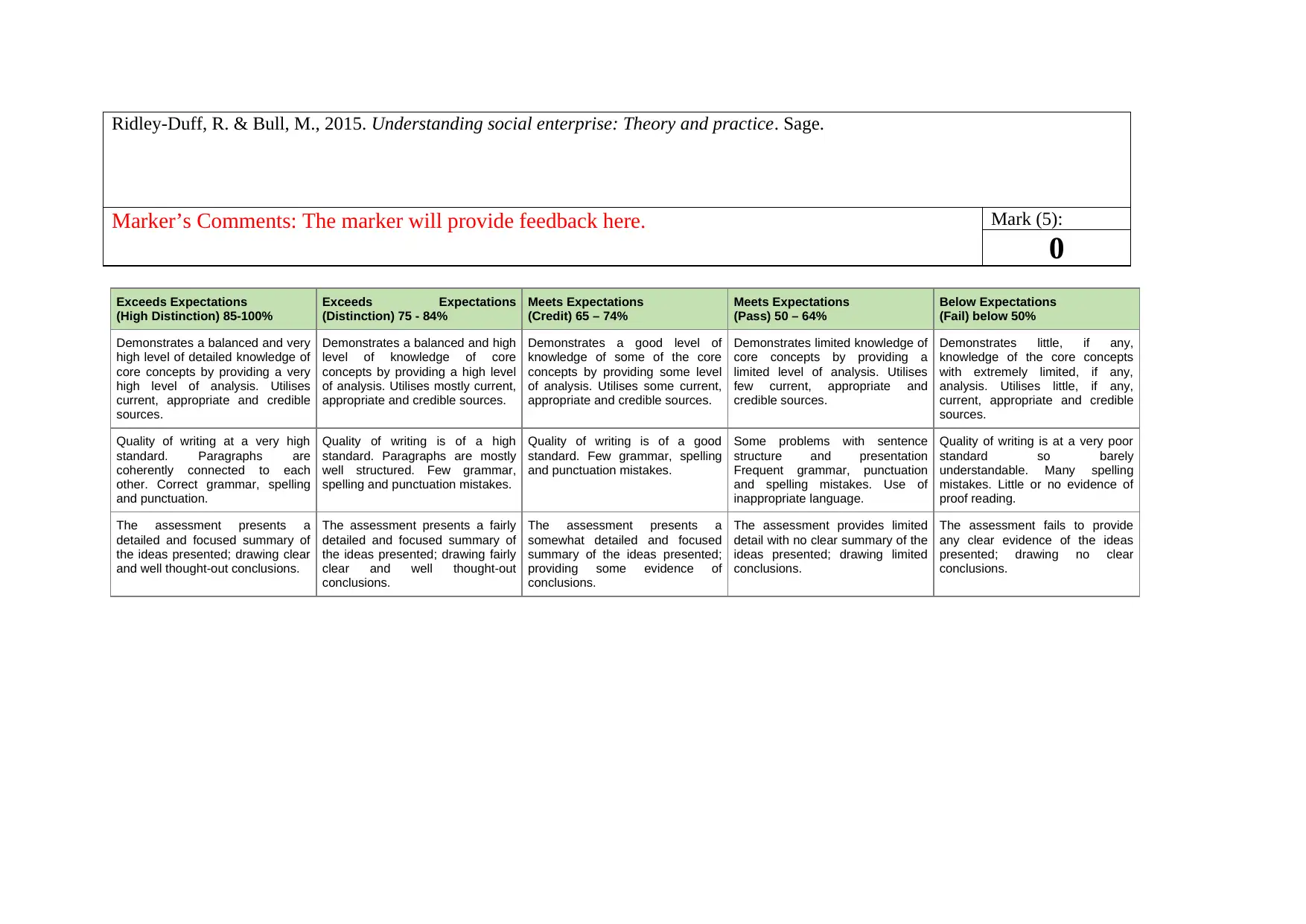
Ridley-Duff, R. & Bull, M., 2015. Understanding social enterprise: Theory and practice. Sage.
Marker’s Comments: The marker will provide feedback here. Mark (5):
0
Exceeds Expectations
(High Distinction) 85-100%
Exceeds Expectations
(Distinction) 75 - 84%
Meets Expectations
(Credit) 65 – 74%
Meets Expectations
(Pass) 50 – 64%
Below Expectations
(Fail) below 50%
Demonstrates a balanced and very
high level of detailed knowledge of
core concepts by providing a very
high level of analysis. Utilises
current, appropriate and credible
sources.
Demonstrates a balanced and high
level of knowledge of core
concepts by providing a high level
of analysis. Utilises mostly current,
appropriate and credible sources.
Demonstrates a good level of
knowledge of some of the core
concepts by providing some level
of analysis. Utilises some current,
appropriate and credible sources.
Demonstrates limited knowledge of
core concepts by providing a
limited level of analysis. Utilises
few current, appropriate and
credible sources.
Demonstrates little, if any,
knowledge of the core concepts
with extremely limited, if any,
analysis. Utilises little, if any,
current, appropriate and credible
sources.
Quality of writing at a very high
standard. Paragraphs are
coherently connected to each
other. Correct grammar, spelling
and punctuation.
Quality of writing is of a high
standard. Paragraphs are mostly
well structured. Few grammar,
spelling and punctuation mistakes.
Quality of writing is of a good
standard. Few grammar, spelling
and punctuation mistakes.
Some problems with sentence
structure and presentation
Frequent grammar, punctuation
and spelling mistakes. Use of
inappropriate language.
Quality of writing is at a very poor
standard so barely
understandable. Many spelling
mistakes. Little or no evidence of
proof reading.
The assessment presents a
detailed and focused summary of
the ideas presented; drawing clear
and well thought-out conclusions.
The assessment presents a fairly
detailed and focused summary of
the ideas presented; drawing fairly
clear and well thought-out
conclusions.
The assessment presents a
somewhat detailed and focused
summary of the ideas presented;
providing some evidence of
conclusions.
The assessment provides limited
detail with no clear summary of the
ideas presented; drawing limited
conclusions.
The assessment fails to provide
any clear evidence of the ideas
presented; drawing no clear
conclusions.
Marker’s Comments: The marker will provide feedback here. Mark (5):
0
Exceeds Expectations
(High Distinction) 85-100%
Exceeds Expectations
(Distinction) 75 - 84%
Meets Expectations
(Credit) 65 – 74%
Meets Expectations
(Pass) 50 – 64%
Below Expectations
(Fail) below 50%
Demonstrates a balanced and very
high level of detailed knowledge of
core concepts by providing a very
high level of analysis. Utilises
current, appropriate and credible
sources.
Demonstrates a balanced and high
level of knowledge of core
concepts by providing a high level
of analysis. Utilises mostly current,
appropriate and credible sources.
Demonstrates a good level of
knowledge of some of the core
concepts by providing some level
of analysis. Utilises some current,
appropriate and credible sources.
Demonstrates limited knowledge of
core concepts by providing a
limited level of analysis. Utilises
few current, appropriate and
credible sources.
Demonstrates little, if any,
knowledge of the core concepts
with extremely limited, if any,
analysis. Utilises little, if any,
current, appropriate and credible
sources.
Quality of writing at a very high
standard. Paragraphs are
coherently connected to each
other. Correct grammar, spelling
and punctuation.
Quality of writing is of a high
standard. Paragraphs are mostly
well structured. Few grammar,
spelling and punctuation mistakes.
Quality of writing is of a good
standard. Few grammar, spelling
and punctuation mistakes.
Some problems with sentence
structure and presentation
Frequent grammar, punctuation
and spelling mistakes. Use of
inappropriate language.
Quality of writing is at a very poor
standard so barely
understandable. Many spelling
mistakes. Little or no evidence of
proof reading.
The assessment presents a
detailed and focused summary of
the ideas presented; drawing clear
and well thought-out conclusions.
The assessment presents a fairly
detailed and focused summary of
the ideas presented; drawing fairly
clear and well thought-out
conclusions.
The assessment presents a
somewhat detailed and focused
summary of the ideas presented;
providing some evidence of
conclusions.
The assessment provides limited
detail with no clear summary of the
ideas presented; drawing limited
conclusions.
The assessment fails to provide
any clear evidence of the ideas
presented; drawing no clear
conclusions.
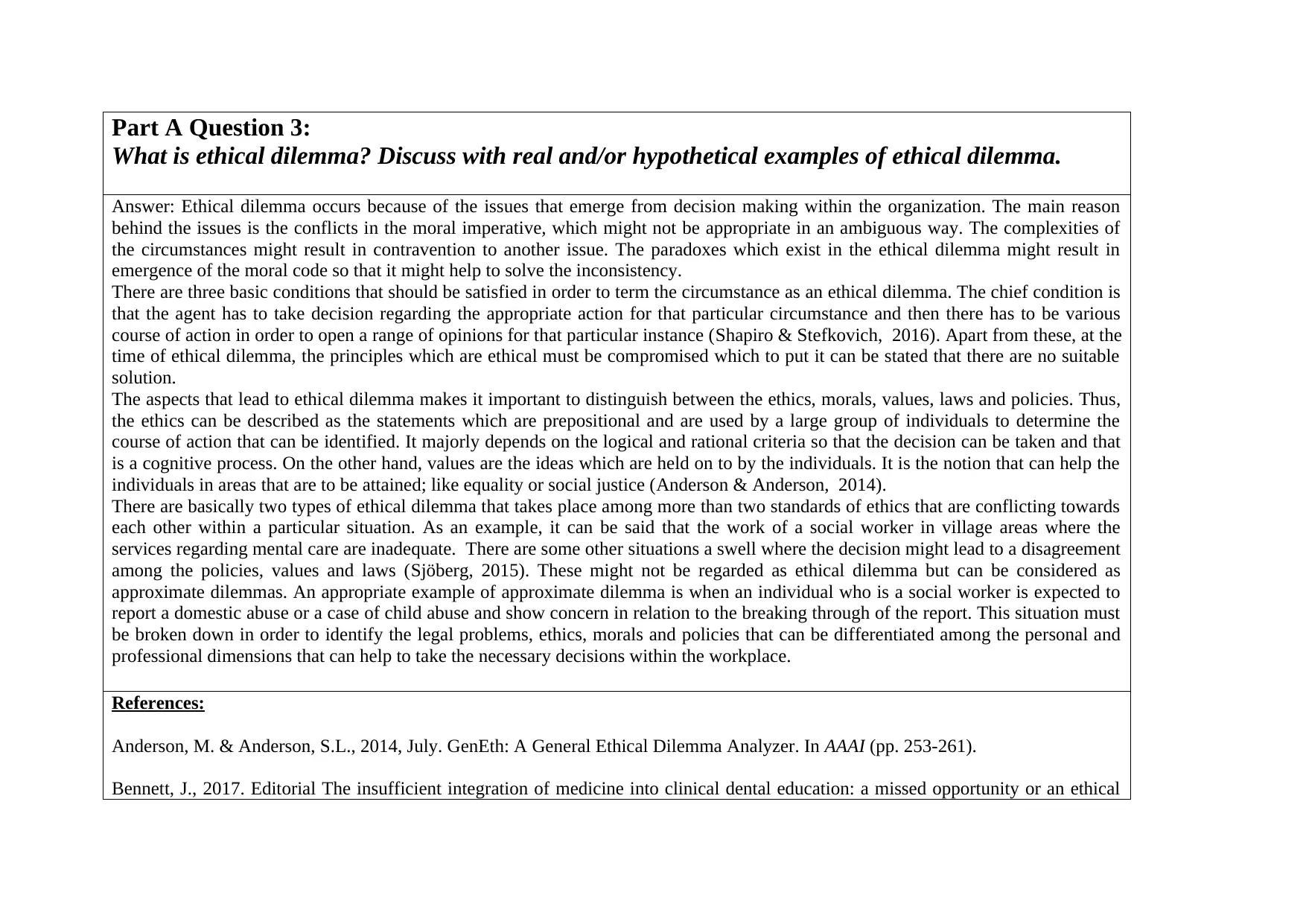
Part A Question 3:
What is ethical dilemma? Discuss with real and/or hypothetical examples of ethical dilemma.
Answer: Ethical dilemma occurs because of the issues that emerge from decision making within the organization. The main reason
behind the issues is the conflicts in the moral imperative, which might not be appropriate in an ambiguous way. The complexities of
the circumstances might result in contravention to another issue. The paradoxes which exist in the ethical dilemma might result in
emergence of the moral code so that it might help to solve the inconsistency.
There are three basic conditions that should be satisfied in order to term the circumstance as an ethical dilemma. The chief condition is
that the agent has to take decision regarding the appropriate action for that particular circumstance and then there has to be various
course of action in order to open a range of opinions for that particular instance (Shapiro & Stefkovich, 2016). Apart from these, at the
time of ethical dilemma, the principles which are ethical must be compromised which to put it can be stated that there are no suitable
solution.
The aspects that lead to ethical dilemma makes it important to distinguish between the ethics, morals, values, laws and policies. Thus,
the ethics can be described as the statements which are prepositional and are used by a large group of individuals to determine the
course of action that can be identified. It majorly depends on the logical and rational criteria so that the decision can be taken and that
is a cognitive process. On the other hand, values are the ideas which are held on to by the individuals. It is the notion that can help the
individuals in areas that are to be attained; like equality or social justice (Anderson & Anderson, 2014).
There are basically two types of ethical dilemma that takes place among more than two standards of ethics that are conflicting towards
each other within a particular situation. As an example, it can be said that the work of a social worker in village areas where the
services regarding mental care are inadequate. There are some other situations a swell where the decision might lead to a disagreement
among the policies, values and laws (Sjöberg, 2015). These might not be regarded as ethical dilemma but can be considered as
approximate dilemmas. An appropriate example of approximate dilemma is when an individual who is a social worker is expected to
report a domestic abuse or a case of child abuse and show concern in relation to the breaking through of the report. This situation must
be broken down in order to identify the legal problems, ethics, morals and policies that can be differentiated among the personal and
professional dimensions that can help to take the necessary decisions within the workplace.
References:
Anderson, M. & Anderson, S.L., 2014, July. GenEth: A General Ethical Dilemma Analyzer. In AAAI (pp. 253-261).
Bennett, J., 2017. Editorial The insufficient integration of medicine into clinical dental education: a missed opportunity or an ethical
What is ethical dilemma? Discuss with real and/or hypothetical examples of ethical dilemma.
Answer: Ethical dilemma occurs because of the issues that emerge from decision making within the organization. The main reason
behind the issues is the conflicts in the moral imperative, which might not be appropriate in an ambiguous way. The complexities of
the circumstances might result in contravention to another issue. The paradoxes which exist in the ethical dilemma might result in
emergence of the moral code so that it might help to solve the inconsistency.
There are three basic conditions that should be satisfied in order to term the circumstance as an ethical dilemma. The chief condition is
that the agent has to take decision regarding the appropriate action for that particular circumstance and then there has to be various
course of action in order to open a range of opinions for that particular instance (Shapiro & Stefkovich, 2016). Apart from these, at the
time of ethical dilemma, the principles which are ethical must be compromised which to put it can be stated that there are no suitable
solution.
The aspects that lead to ethical dilemma makes it important to distinguish between the ethics, morals, values, laws and policies. Thus,
the ethics can be described as the statements which are prepositional and are used by a large group of individuals to determine the
course of action that can be identified. It majorly depends on the logical and rational criteria so that the decision can be taken and that
is a cognitive process. On the other hand, values are the ideas which are held on to by the individuals. It is the notion that can help the
individuals in areas that are to be attained; like equality or social justice (Anderson & Anderson, 2014).
There are basically two types of ethical dilemma that takes place among more than two standards of ethics that are conflicting towards
each other within a particular situation. As an example, it can be said that the work of a social worker in village areas where the
services regarding mental care are inadequate. There are some other situations a swell where the decision might lead to a disagreement
among the policies, values and laws (Sjöberg, 2015). These might not be regarded as ethical dilemma but can be considered as
approximate dilemmas. An appropriate example of approximate dilemma is when an individual who is a social worker is expected to
report a domestic abuse or a case of child abuse and show concern in relation to the breaking through of the report. This situation must
be broken down in order to identify the legal problems, ethics, morals and policies that can be differentiated among the personal and
professional dimensions that can help to take the necessary decisions within the workplace.
References:
Anderson, M. & Anderson, S.L., 2014, July. GenEth: A General Ethical Dilemma Analyzer. In AAAI (pp. 253-261).
Bennett, J., 2017. Editorial The insufficient integration of medicine into clinical dental education: a missed opportunity or an ethical
⊘ This is a preview!⊘
Do you want full access?
Subscribe today to unlock all pages.

Trusted by 1+ million students worldwide
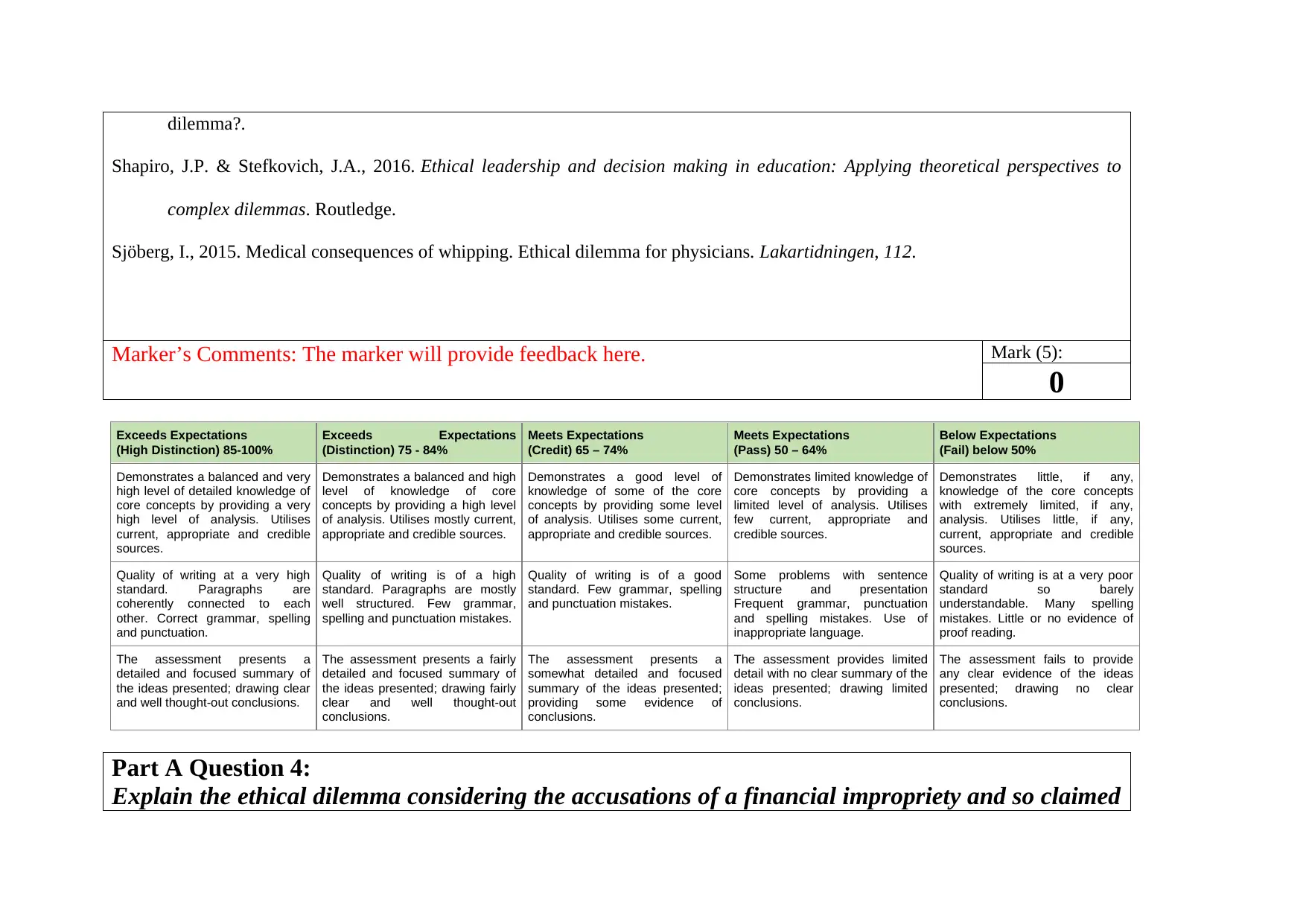
dilemma?.
Shapiro, J.P. & Stefkovich, J.A., 2016. Ethical leadership and decision making in education: Applying theoretical perspectives to
complex dilemmas. Routledge.
Sjöberg, I., 2015. Medical consequences of whipping. Ethical dilemma for physicians. Lakartidningen, 112.
Marker’s Comments: The marker will provide feedback here. Mark (5):
0
Exceeds Expectations
(High Distinction) 85-100%
Exceeds Expectations
(Distinction) 75 - 84%
Meets Expectations
(Credit) 65 – 74%
Meets Expectations
(Pass) 50 – 64%
Below Expectations
(Fail) below 50%
Demonstrates a balanced and very
high level of detailed knowledge of
core concepts by providing a very
high level of analysis. Utilises
current, appropriate and credible
sources.
Demonstrates a balanced and high
level of knowledge of core
concepts by providing a high level
of analysis. Utilises mostly current,
appropriate and credible sources.
Demonstrates a good level of
knowledge of some of the core
concepts by providing some level
of analysis. Utilises some current,
appropriate and credible sources.
Demonstrates limited knowledge of
core concepts by providing a
limited level of analysis. Utilises
few current, appropriate and
credible sources.
Demonstrates little, if any,
knowledge of the core concepts
with extremely limited, if any,
analysis. Utilises little, if any,
current, appropriate and credible
sources.
Quality of writing at a very high
standard. Paragraphs are
coherently connected to each
other. Correct grammar, spelling
and punctuation.
Quality of writing is of a high
standard. Paragraphs are mostly
well structured. Few grammar,
spelling and punctuation mistakes.
Quality of writing is of a good
standard. Few grammar, spelling
and punctuation mistakes.
Some problems with sentence
structure and presentation
Frequent grammar, punctuation
and spelling mistakes. Use of
inappropriate language.
Quality of writing is at a very poor
standard so barely
understandable. Many spelling
mistakes. Little or no evidence of
proof reading.
The assessment presents a
detailed and focused summary of
the ideas presented; drawing clear
and well thought-out conclusions.
The assessment presents a fairly
detailed and focused summary of
the ideas presented; drawing fairly
clear and well thought-out
conclusions.
The assessment presents a
somewhat detailed and focused
summary of the ideas presented;
providing some evidence of
conclusions.
The assessment provides limited
detail with no clear summary of the
ideas presented; drawing limited
conclusions.
The assessment fails to provide
any clear evidence of the ideas
presented; drawing no clear
conclusions.
Part A Question 4:
Explain the ethical dilemma considering the accusations of a financial impropriety and so claimed
Shapiro, J.P. & Stefkovich, J.A., 2016. Ethical leadership and decision making in education: Applying theoretical perspectives to
complex dilemmas. Routledge.
Sjöberg, I., 2015. Medical consequences of whipping. Ethical dilemma for physicians. Lakartidningen, 112.
Marker’s Comments: The marker will provide feedback here. Mark (5):
0
Exceeds Expectations
(High Distinction) 85-100%
Exceeds Expectations
(Distinction) 75 - 84%
Meets Expectations
(Credit) 65 – 74%
Meets Expectations
(Pass) 50 – 64%
Below Expectations
(Fail) below 50%
Demonstrates a balanced and very
high level of detailed knowledge of
core concepts by providing a very
high level of analysis. Utilises
current, appropriate and credible
sources.
Demonstrates a balanced and high
level of knowledge of core
concepts by providing a high level
of analysis. Utilises mostly current,
appropriate and credible sources.
Demonstrates a good level of
knowledge of some of the core
concepts by providing some level
of analysis. Utilises some current,
appropriate and credible sources.
Demonstrates limited knowledge of
core concepts by providing a
limited level of analysis. Utilises
few current, appropriate and
credible sources.
Demonstrates little, if any,
knowledge of the core concepts
with extremely limited, if any,
analysis. Utilises little, if any,
current, appropriate and credible
sources.
Quality of writing at a very high
standard. Paragraphs are
coherently connected to each
other. Correct grammar, spelling
and punctuation.
Quality of writing is of a high
standard. Paragraphs are mostly
well structured. Few grammar,
spelling and punctuation mistakes.
Quality of writing is of a good
standard. Few grammar, spelling
and punctuation mistakes.
Some problems with sentence
structure and presentation
Frequent grammar, punctuation
and spelling mistakes. Use of
inappropriate language.
Quality of writing is at a very poor
standard so barely
understandable. Many spelling
mistakes. Little or no evidence of
proof reading.
The assessment presents a
detailed and focused summary of
the ideas presented; drawing clear
and well thought-out conclusions.
The assessment presents a fairly
detailed and focused summary of
the ideas presented; drawing fairly
clear and well thought-out
conclusions.
The assessment presents a
somewhat detailed and focused
summary of the ideas presented;
providing some evidence of
conclusions.
The assessment provides limited
detail with no clear summary of the
ideas presented; drawing limited
conclusions.
The assessment fails to provide
any clear evidence of the ideas
presented; drawing no clear
conclusions.
Part A Question 4:
Explain the ethical dilemma considering the accusations of a financial impropriety and so claimed
Paraphrase This Document
Need a fresh take? Get an instant paraphrase of this document with our AI Paraphraser
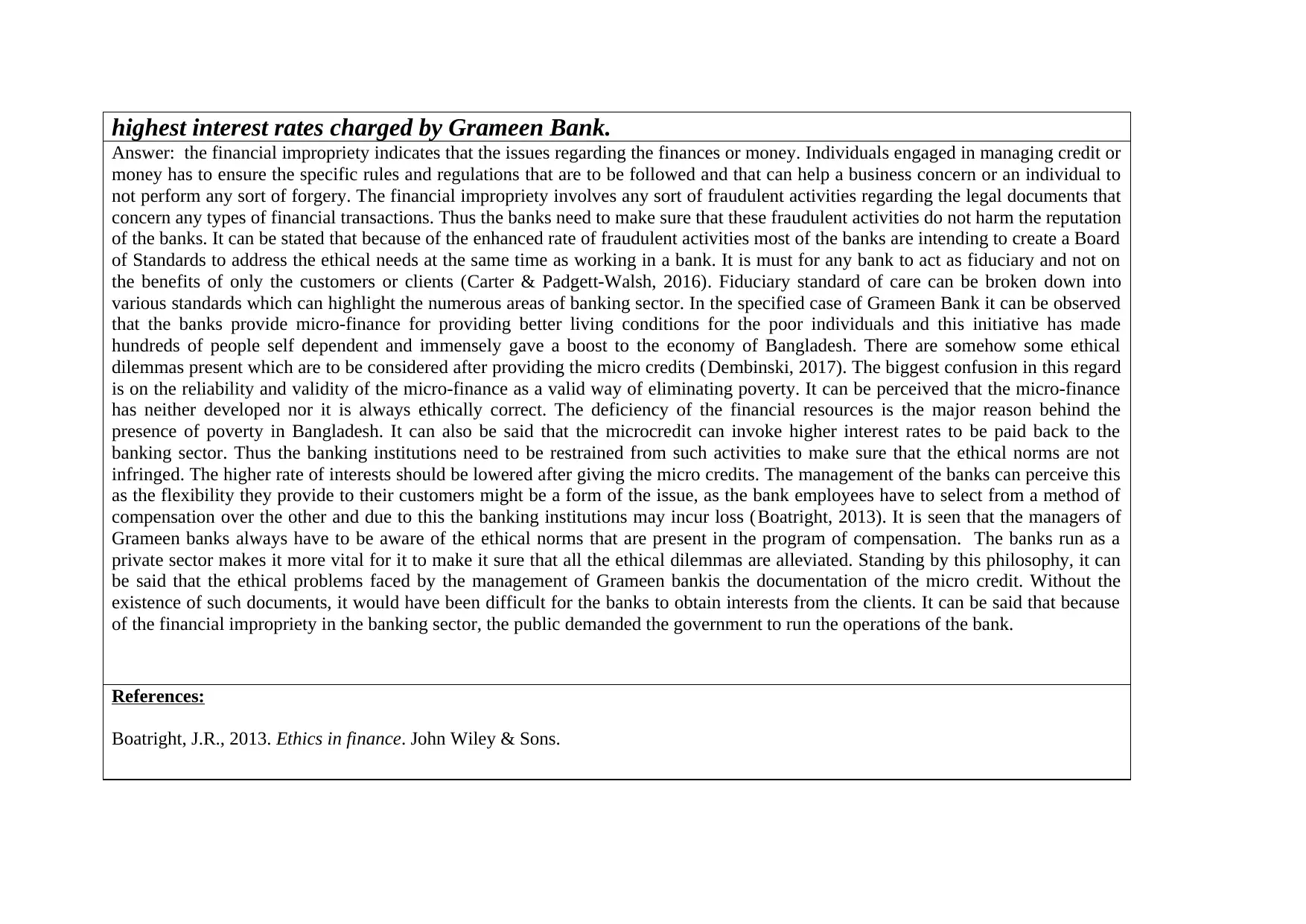
highest interest rates charged by Grameen Bank.
Answer: the financial impropriety indicates that the issues regarding the finances or money. Individuals engaged in managing credit or
money has to ensure the specific rules and regulations that are to be followed and that can help a business concern or an individual to
not perform any sort of forgery. The financial impropriety involves any sort of fraudulent activities regarding the legal documents that
concern any types of financial transactions. Thus the banks need to make sure that these fraudulent activities do not harm the reputation
of the banks. It can be stated that because of the enhanced rate of fraudulent activities most of the banks are intending to create a Board
of Standards to address the ethical needs at the same time as working in a bank. It is must for any bank to act as fiduciary and not on
the benefits of only the customers or clients (Carter & Padgett-Walsh, 2016). Fiduciary standard of care can be broken down into
various standards which can highlight the numerous areas of banking sector. In the specified case of Grameen Bank it can be observed
that the banks provide micro-finance for providing better living conditions for the poor individuals and this initiative has made
hundreds of people self dependent and immensely gave a boost to the economy of Bangladesh. There are somehow some ethical
dilemmas present which are to be considered after providing the micro credits (Dembinski, 2017). The biggest confusion in this regard
is on the reliability and validity of the micro-finance as a valid way of eliminating poverty. It can be perceived that the micro-finance
has neither developed nor it is always ethically correct. The deficiency of the financial resources is the major reason behind the
presence of poverty in Bangladesh. It can also be said that the microcredit can invoke higher interest rates to be paid back to the
banking sector. Thus the banking institutions need to be restrained from such activities to make sure that the ethical norms are not
infringed. The higher rate of interests should be lowered after giving the micro credits. The management of the banks can perceive this
as the flexibility they provide to their customers might be a form of the issue, as the bank employees have to select from a method of
compensation over the other and due to this the banking institutions may incur loss (Boatright, 2013). It is seen that the managers of
Grameen banks always have to be aware of the ethical norms that are present in the program of compensation. The banks run as a
private sector makes it more vital for it to make it sure that all the ethical dilemmas are alleviated. Standing by this philosophy, it can
be said that the ethical problems faced by the management of Grameen bankis the documentation of the micro credit. Without the
existence of such documents, it would have been difficult for the banks to obtain interests from the clients. It can be said that because
of the financial impropriety in the banking sector, the public demanded the government to run the operations of the bank.
References:
Boatright, J.R., 2013. Ethics in finance. John Wiley & Sons.
Answer: the financial impropriety indicates that the issues regarding the finances or money. Individuals engaged in managing credit or
money has to ensure the specific rules and regulations that are to be followed and that can help a business concern or an individual to
not perform any sort of forgery. The financial impropriety involves any sort of fraudulent activities regarding the legal documents that
concern any types of financial transactions. Thus the banks need to make sure that these fraudulent activities do not harm the reputation
of the banks. It can be stated that because of the enhanced rate of fraudulent activities most of the banks are intending to create a Board
of Standards to address the ethical needs at the same time as working in a bank. It is must for any bank to act as fiduciary and not on
the benefits of only the customers or clients (Carter & Padgett-Walsh, 2016). Fiduciary standard of care can be broken down into
various standards which can highlight the numerous areas of banking sector. In the specified case of Grameen Bank it can be observed
that the banks provide micro-finance for providing better living conditions for the poor individuals and this initiative has made
hundreds of people self dependent and immensely gave a boost to the economy of Bangladesh. There are somehow some ethical
dilemmas present which are to be considered after providing the micro credits (Dembinski, 2017). The biggest confusion in this regard
is on the reliability and validity of the micro-finance as a valid way of eliminating poverty. It can be perceived that the micro-finance
has neither developed nor it is always ethically correct. The deficiency of the financial resources is the major reason behind the
presence of poverty in Bangladesh. It can also be said that the microcredit can invoke higher interest rates to be paid back to the
banking sector. Thus the banking institutions need to be restrained from such activities to make sure that the ethical norms are not
infringed. The higher rate of interests should be lowered after giving the micro credits. The management of the banks can perceive this
as the flexibility they provide to their customers might be a form of the issue, as the bank employees have to select from a method of
compensation over the other and due to this the banking institutions may incur loss (Boatright, 2013). It is seen that the managers of
Grameen banks always have to be aware of the ethical norms that are present in the program of compensation. The banks run as a
private sector makes it more vital for it to make it sure that all the ethical dilemmas are alleviated. Standing by this philosophy, it can
be said that the ethical problems faced by the management of Grameen bankis the documentation of the micro credit. Without the
existence of such documents, it would have been difficult for the banks to obtain interests from the clients. It can be said that because
of the financial impropriety in the banking sector, the public demanded the government to run the operations of the bank.
References:
Boatright, J.R., 2013. Ethics in finance. John Wiley & Sons.
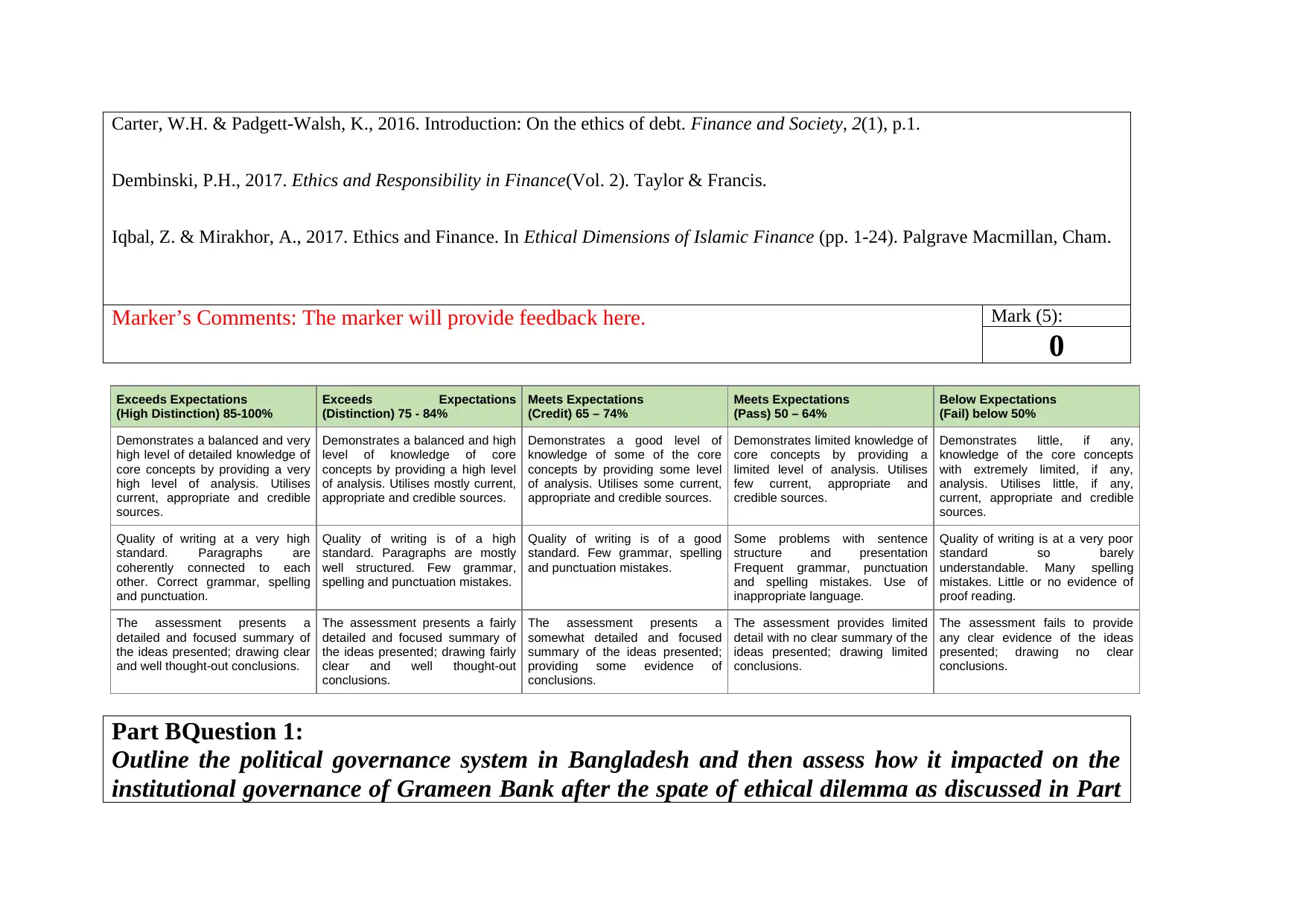
Carter, W.H. & Padgett-Walsh, K., 2016. Introduction: On the ethics of debt. Finance and Society, 2(1), p.1.
Dembinski, P.H., 2017. Ethics and Responsibility in Finance(Vol. 2). Taylor & Francis.
Iqbal, Z. & Mirakhor, A., 2017. Ethics and Finance. In Ethical Dimensions of Islamic Finance (pp. 1-24). Palgrave Macmillan, Cham.
Marker’s Comments: The marker will provide feedback here. Mark (5):
0
Exceeds Expectations
(High Distinction) 85-100%
Exceeds Expectations
(Distinction) 75 - 84%
Meets Expectations
(Credit) 65 – 74%
Meets Expectations
(Pass) 50 – 64%
Below Expectations
(Fail) below 50%
Demonstrates a balanced and very
high level of detailed knowledge of
core concepts by providing a very
high level of analysis. Utilises
current, appropriate and credible
sources.
Demonstrates a balanced and high
level of knowledge of core
concepts by providing a high level
of analysis. Utilises mostly current,
appropriate and credible sources.
Demonstrates a good level of
knowledge of some of the core
concepts by providing some level
of analysis. Utilises some current,
appropriate and credible sources.
Demonstrates limited knowledge of
core concepts by providing a
limited level of analysis. Utilises
few current, appropriate and
credible sources.
Demonstrates little, if any,
knowledge of the core concepts
with extremely limited, if any,
analysis. Utilises little, if any,
current, appropriate and credible
sources.
Quality of writing at a very high
standard. Paragraphs are
coherently connected to each
other. Correct grammar, spelling
and punctuation.
Quality of writing is of a high
standard. Paragraphs are mostly
well structured. Few grammar,
spelling and punctuation mistakes.
Quality of writing is of a good
standard. Few grammar, spelling
and punctuation mistakes.
Some problems with sentence
structure and presentation
Frequent grammar, punctuation
and spelling mistakes. Use of
inappropriate language.
Quality of writing is at a very poor
standard so barely
understandable. Many spelling
mistakes. Little or no evidence of
proof reading.
The assessment presents a
detailed and focused summary of
the ideas presented; drawing clear
and well thought-out conclusions.
The assessment presents a fairly
detailed and focused summary of
the ideas presented; drawing fairly
clear and well thought-out
conclusions.
The assessment presents a
somewhat detailed and focused
summary of the ideas presented;
providing some evidence of
conclusions.
The assessment provides limited
detail with no clear summary of the
ideas presented; drawing limited
conclusions.
The assessment fails to provide
any clear evidence of the ideas
presented; drawing no clear
conclusions.
Part BQuestion 1:
Outline the political governance system in Bangladesh and then assess how it impacted on the
institutional governance of Grameen Bank after the spate of ethical dilemma as discussed in Part
Dembinski, P.H., 2017. Ethics and Responsibility in Finance(Vol. 2). Taylor & Francis.
Iqbal, Z. & Mirakhor, A., 2017. Ethics and Finance. In Ethical Dimensions of Islamic Finance (pp. 1-24). Palgrave Macmillan, Cham.
Marker’s Comments: The marker will provide feedback here. Mark (5):
0
Exceeds Expectations
(High Distinction) 85-100%
Exceeds Expectations
(Distinction) 75 - 84%
Meets Expectations
(Credit) 65 – 74%
Meets Expectations
(Pass) 50 – 64%
Below Expectations
(Fail) below 50%
Demonstrates a balanced and very
high level of detailed knowledge of
core concepts by providing a very
high level of analysis. Utilises
current, appropriate and credible
sources.
Demonstrates a balanced and high
level of knowledge of core
concepts by providing a high level
of analysis. Utilises mostly current,
appropriate and credible sources.
Demonstrates a good level of
knowledge of some of the core
concepts by providing some level
of analysis. Utilises some current,
appropriate and credible sources.
Demonstrates limited knowledge of
core concepts by providing a
limited level of analysis. Utilises
few current, appropriate and
credible sources.
Demonstrates little, if any,
knowledge of the core concepts
with extremely limited, if any,
analysis. Utilises little, if any,
current, appropriate and credible
sources.
Quality of writing at a very high
standard. Paragraphs are
coherently connected to each
other. Correct grammar, spelling
and punctuation.
Quality of writing is of a high
standard. Paragraphs are mostly
well structured. Few grammar,
spelling and punctuation mistakes.
Quality of writing is of a good
standard. Few grammar, spelling
and punctuation mistakes.
Some problems with sentence
structure and presentation
Frequent grammar, punctuation
and spelling mistakes. Use of
inappropriate language.
Quality of writing is at a very poor
standard so barely
understandable. Many spelling
mistakes. Little or no evidence of
proof reading.
The assessment presents a
detailed and focused summary of
the ideas presented; drawing clear
and well thought-out conclusions.
The assessment presents a fairly
detailed and focused summary of
the ideas presented; drawing fairly
clear and well thought-out
conclusions.
The assessment presents a
somewhat detailed and focused
summary of the ideas presented;
providing some evidence of
conclusions.
The assessment provides limited
detail with no clear summary of the
ideas presented; drawing limited
conclusions.
The assessment fails to provide
any clear evidence of the ideas
presented; drawing no clear
conclusions.
Part BQuestion 1:
Outline the political governance system in Bangladesh and then assess how it impacted on the
institutional governance of Grameen Bank after the spate of ethical dilemma as discussed in Part
⊘ This is a preview!⊘
Do you want full access?
Subscribe today to unlock all pages.

Trusted by 1+ million students worldwide
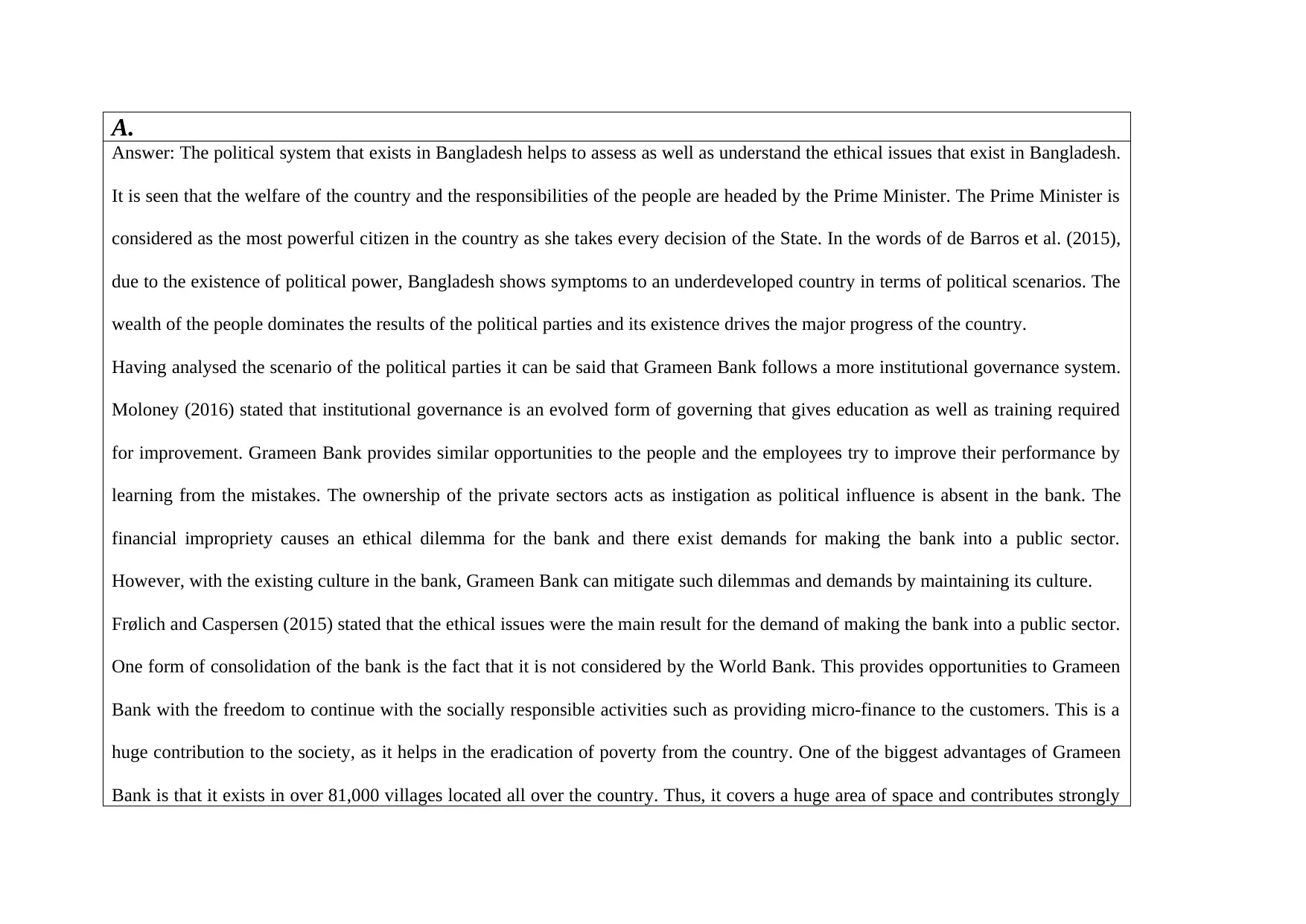
A.
Answer: The political system that exists in Bangladesh helps to assess as well as understand the ethical issues that exist in Bangladesh.
It is seen that the welfare of the country and the responsibilities of the people are headed by the Prime Minister. The Prime Minister is
considered as the most powerful citizen in the country as she takes every decision of the State. In the words of de Barros et al. (2015),
due to the existence of political power, Bangladesh shows symptoms to an underdeveloped country in terms of political scenarios. The
wealth of the people dominates the results of the political parties and its existence drives the major progress of the country.
Having analysed the scenario of the political parties it can be said that Grameen Bank follows a more institutional governance system.
Moloney (2016) stated that institutional governance is an evolved form of governing that gives education as well as training required
for improvement. Grameen Bank provides similar opportunities to the people and the employees try to improve their performance by
learning from the mistakes. The ownership of the private sectors acts as instigation as political influence is absent in the bank. The
financial impropriety causes an ethical dilemma for the bank and there exist demands for making the bank into a public sector.
However, with the existing culture in the bank, Grameen Bank can mitigate such dilemmas and demands by maintaining its culture.
Frølich and Caspersen (2015) stated that the ethical issues were the main result for the demand of making the bank into a public sector.
One form of consolidation of the bank is the fact that it is not considered by the World Bank. This provides opportunities to Grameen
Bank with the freedom to continue with the socially responsible activities such as providing micro-finance to the customers. This is a
huge contribution to the society, as it helps in the eradication of poverty from the country. One of the biggest advantages of Grameen
Bank is that it exists in over 81,000 villages located all over the country. Thus, it covers a huge area of space and contributes strongly
Answer: The political system that exists in Bangladesh helps to assess as well as understand the ethical issues that exist in Bangladesh.
It is seen that the welfare of the country and the responsibilities of the people are headed by the Prime Minister. The Prime Minister is
considered as the most powerful citizen in the country as she takes every decision of the State. In the words of de Barros et al. (2015),
due to the existence of political power, Bangladesh shows symptoms to an underdeveloped country in terms of political scenarios. The
wealth of the people dominates the results of the political parties and its existence drives the major progress of the country.
Having analysed the scenario of the political parties it can be said that Grameen Bank follows a more institutional governance system.
Moloney (2016) stated that institutional governance is an evolved form of governing that gives education as well as training required
for improvement. Grameen Bank provides similar opportunities to the people and the employees try to improve their performance by
learning from the mistakes. The ownership of the private sectors acts as instigation as political influence is absent in the bank. The
financial impropriety causes an ethical dilemma for the bank and there exist demands for making the bank into a public sector.
However, with the existing culture in the bank, Grameen Bank can mitigate such dilemmas and demands by maintaining its culture.
Frølich and Caspersen (2015) stated that the ethical issues were the main result for the demand of making the bank into a public sector.
One form of consolidation of the bank is the fact that it is not considered by the World Bank. This provides opportunities to Grameen
Bank with the freedom to continue with the socially responsible activities such as providing micro-finance to the customers. This is a
huge contribution to the society, as it helps in the eradication of poverty from the country. One of the biggest advantages of Grameen
Bank is that it exists in over 81,000 villages located all over the country. Thus, it covers a huge area of space and contributes strongly
Paraphrase This Document
Need a fresh take? Get an instant paraphrase of this document with our AI Paraphraser
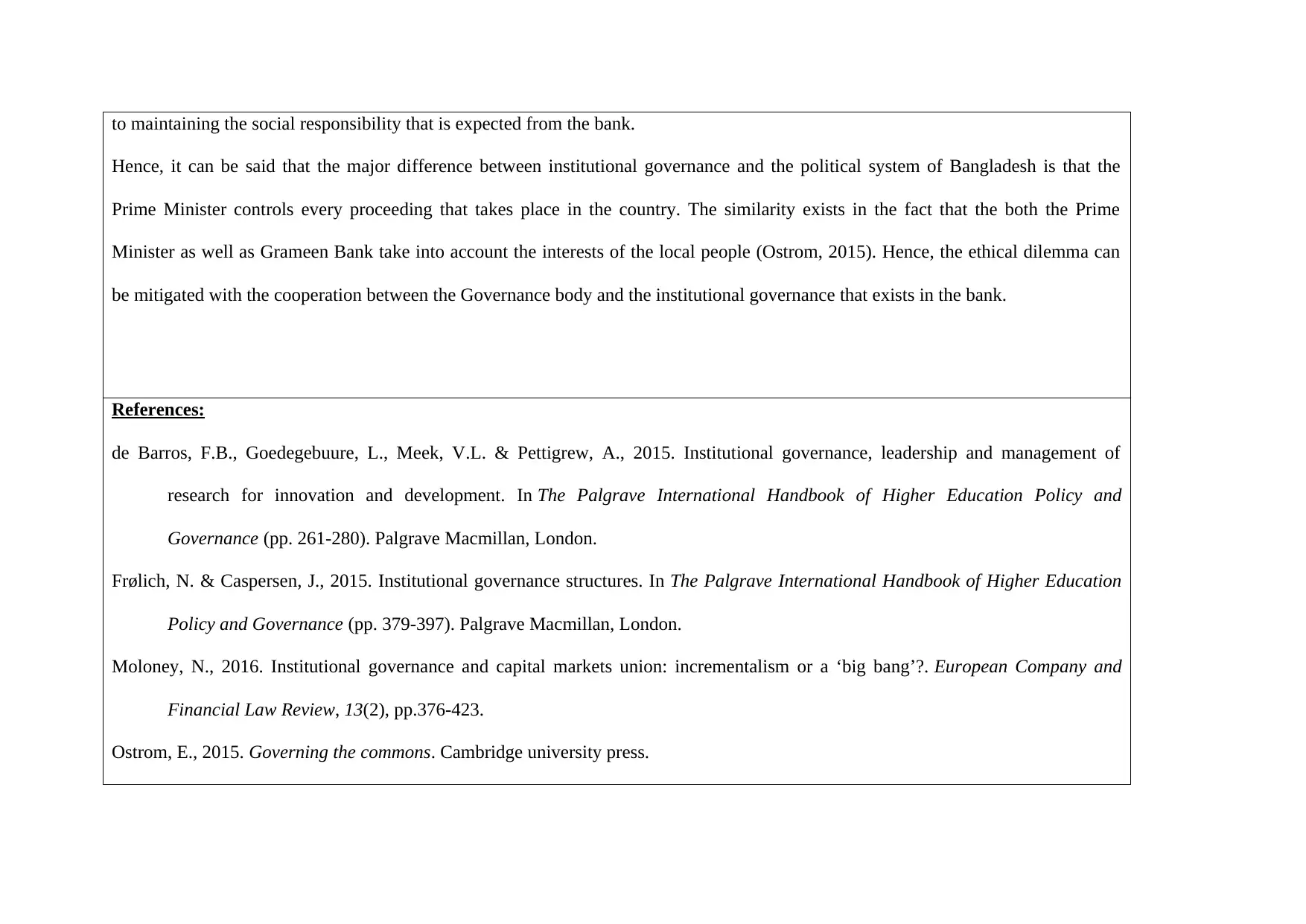
to maintaining the social responsibility that is expected from the bank.
Hence, it can be said that the major difference between institutional governance and the political system of Bangladesh is that the
Prime Minister controls every proceeding that takes place in the country. The similarity exists in the fact that the both the Prime
Minister as well as Grameen Bank take into account the interests of the local people (Ostrom, 2015). Hence, the ethical dilemma can
be mitigated with the cooperation between the Governance body and the institutional governance that exists in the bank.
References:
de Barros, F.B., Goedegebuure, L., Meek, V.L. & Pettigrew, A., 2015. Institutional governance, leadership and management of
research for innovation and development. In The Palgrave International Handbook of Higher Education Policy and
Governance (pp. 261-280). Palgrave Macmillan, London.
Frølich, N. & Caspersen, J., 2015. Institutional governance structures. In The Palgrave International Handbook of Higher Education
Policy and Governance (pp. 379-397). Palgrave Macmillan, London.
Moloney, N., 2016. Institutional governance and capital markets union: incrementalism or a ‘big bang’?. European Company and
Financial Law Review, 13(2), pp.376-423.
Ostrom, E., 2015. Governing the commons. Cambridge university press.
Hence, it can be said that the major difference between institutional governance and the political system of Bangladesh is that the
Prime Minister controls every proceeding that takes place in the country. The similarity exists in the fact that the both the Prime
Minister as well as Grameen Bank take into account the interests of the local people (Ostrom, 2015). Hence, the ethical dilemma can
be mitigated with the cooperation between the Governance body and the institutional governance that exists in the bank.
References:
de Barros, F.B., Goedegebuure, L., Meek, V.L. & Pettigrew, A., 2015. Institutional governance, leadership and management of
research for innovation and development. In The Palgrave International Handbook of Higher Education Policy and
Governance (pp. 261-280). Palgrave Macmillan, London.
Frølich, N. & Caspersen, J., 2015. Institutional governance structures. In The Palgrave International Handbook of Higher Education
Policy and Governance (pp. 379-397). Palgrave Macmillan, London.
Moloney, N., 2016. Institutional governance and capital markets union: incrementalism or a ‘big bang’?. European Company and
Financial Law Review, 13(2), pp.376-423.
Ostrom, E., 2015. Governing the commons. Cambridge university press.
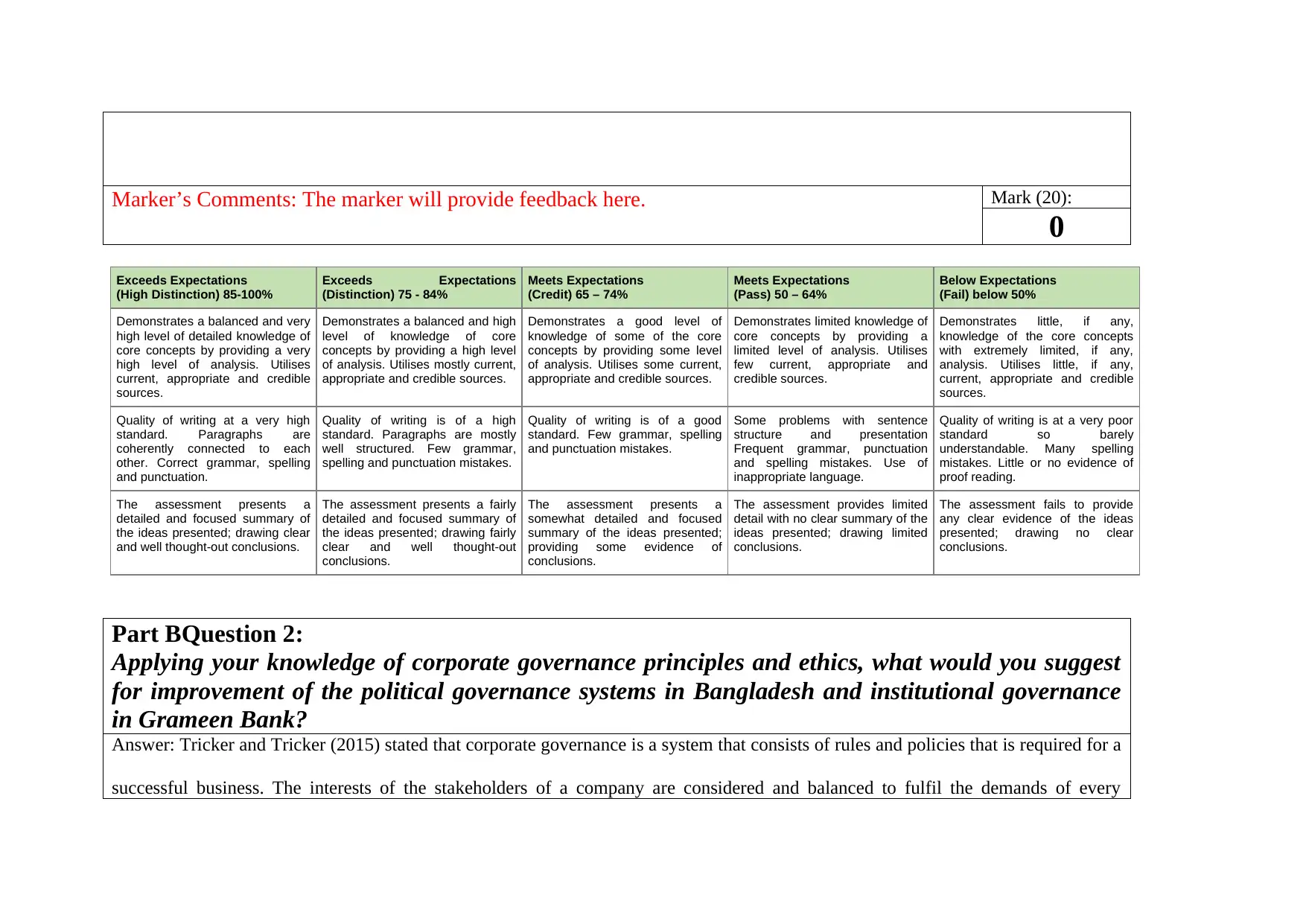
Marker’s Comments: The marker will provide feedback here. Mark (20):
0
Exceeds Expectations
(High Distinction) 85-100%
Exceeds Expectations
(Distinction) 75 - 84%
Meets Expectations
(Credit) 65 – 74%
Meets Expectations
(Pass) 50 – 64%
Below Expectations
(Fail) below 50%
Demonstrates a balanced and very
high level of detailed knowledge of
core concepts by providing a very
high level of analysis. Utilises
current, appropriate and credible
sources.
Demonstrates a balanced and high
level of knowledge of core
concepts by providing a high level
of analysis. Utilises mostly current,
appropriate and credible sources.
Demonstrates a good level of
knowledge of some of the core
concepts by providing some level
of analysis. Utilises some current,
appropriate and credible sources.
Demonstrates limited knowledge of
core concepts by providing a
limited level of analysis. Utilises
few current, appropriate and
credible sources.
Demonstrates little, if any,
knowledge of the core concepts
with extremely limited, if any,
analysis. Utilises little, if any,
current, appropriate and credible
sources.
Quality of writing at a very high
standard. Paragraphs are
coherently connected to each
other. Correct grammar, spelling
and punctuation.
Quality of writing is of a high
standard. Paragraphs are mostly
well structured. Few grammar,
spelling and punctuation mistakes.
Quality of writing is of a good
standard. Few grammar, spelling
and punctuation mistakes.
Some problems with sentence
structure and presentation
Frequent grammar, punctuation
and spelling mistakes. Use of
inappropriate language.
Quality of writing is at a very poor
standard so barely
understandable. Many spelling
mistakes. Little or no evidence of
proof reading.
The assessment presents a
detailed and focused summary of
the ideas presented; drawing clear
and well thought-out conclusions.
The assessment presents a fairly
detailed and focused summary of
the ideas presented; drawing fairly
clear and well thought-out
conclusions.
The assessment presents a
somewhat detailed and focused
summary of the ideas presented;
providing some evidence of
conclusions.
The assessment provides limited
detail with no clear summary of the
ideas presented; drawing limited
conclusions.
The assessment fails to provide
any clear evidence of the ideas
presented; drawing no clear
conclusions.
Part BQuestion 2:
Applying your knowledge of corporate governance principles and ethics, what would you suggest
for improvement of the political governance systems in Bangladesh and institutional governance
in Grameen Bank?
Answer: Tricker and Tricker (2015) stated that corporate governance is a system that consists of rules and policies that is required for a
successful business. The interests of the stakeholders of a company are considered and balanced to fulfil the demands of every
0
Exceeds Expectations
(High Distinction) 85-100%
Exceeds Expectations
(Distinction) 75 - 84%
Meets Expectations
(Credit) 65 – 74%
Meets Expectations
(Pass) 50 – 64%
Below Expectations
(Fail) below 50%
Demonstrates a balanced and very
high level of detailed knowledge of
core concepts by providing a very
high level of analysis. Utilises
current, appropriate and credible
sources.
Demonstrates a balanced and high
level of knowledge of core
concepts by providing a high level
of analysis. Utilises mostly current,
appropriate and credible sources.
Demonstrates a good level of
knowledge of some of the core
concepts by providing some level
of analysis. Utilises some current,
appropriate and credible sources.
Demonstrates limited knowledge of
core concepts by providing a
limited level of analysis. Utilises
few current, appropriate and
credible sources.
Demonstrates little, if any,
knowledge of the core concepts
with extremely limited, if any,
analysis. Utilises little, if any,
current, appropriate and credible
sources.
Quality of writing at a very high
standard. Paragraphs are
coherently connected to each
other. Correct grammar, spelling
and punctuation.
Quality of writing is of a high
standard. Paragraphs are mostly
well structured. Few grammar,
spelling and punctuation mistakes.
Quality of writing is of a good
standard. Few grammar, spelling
and punctuation mistakes.
Some problems with sentence
structure and presentation
Frequent grammar, punctuation
and spelling mistakes. Use of
inappropriate language.
Quality of writing is at a very poor
standard so barely
understandable. Many spelling
mistakes. Little or no evidence of
proof reading.
The assessment presents a
detailed and focused summary of
the ideas presented; drawing clear
and well thought-out conclusions.
The assessment presents a fairly
detailed and focused summary of
the ideas presented; drawing fairly
clear and well thought-out
conclusions.
The assessment presents a
somewhat detailed and focused
summary of the ideas presented;
providing some evidence of
conclusions.
The assessment provides limited
detail with no clear summary of the
ideas presented; drawing limited
conclusions.
The assessment fails to provide
any clear evidence of the ideas
presented; drawing no clear
conclusions.
Part BQuestion 2:
Applying your knowledge of corporate governance principles and ethics, what would you suggest
for improvement of the political governance systems in Bangladesh and institutional governance
in Grameen Bank?
Answer: Tricker and Tricker (2015) stated that corporate governance is a system that consists of rules and policies that is required for a
successful business. The interests of the stakeholders of a company are considered and balanced to fulfil the demands of every
⊘ This is a preview!⊘
Do you want full access?
Subscribe today to unlock all pages.

Trusted by 1+ million students worldwide
1 out of 15
Related Documents
Your All-in-One AI-Powered Toolkit for Academic Success.
+13062052269
info@desklib.com
Available 24*7 on WhatsApp / Email
![[object Object]](/_next/static/media/star-bottom.7253800d.svg)
Unlock your academic potential
Copyright © 2020–2025 A2Z Services. All Rights Reserved. Developed and managed by ZUCOL.





